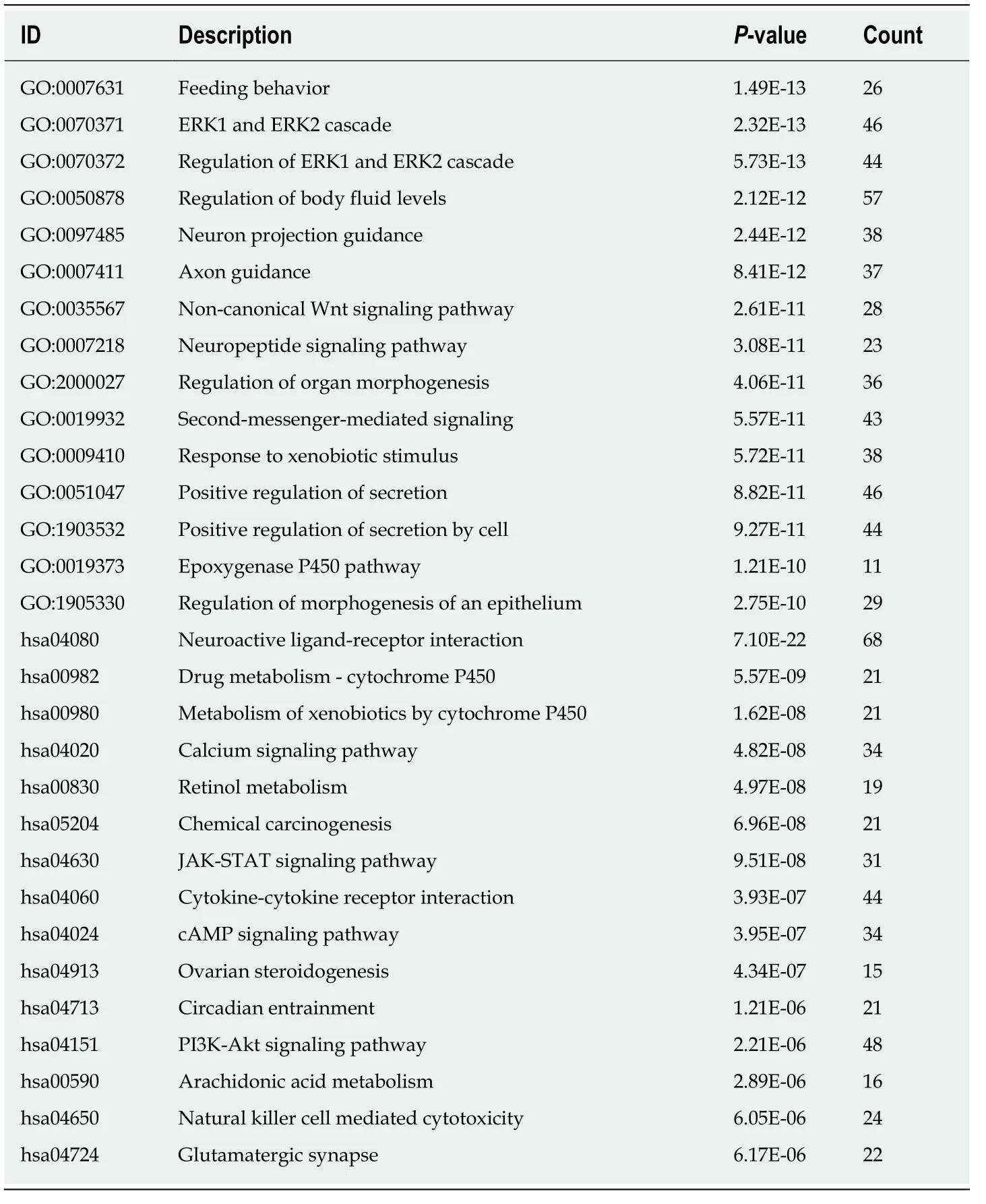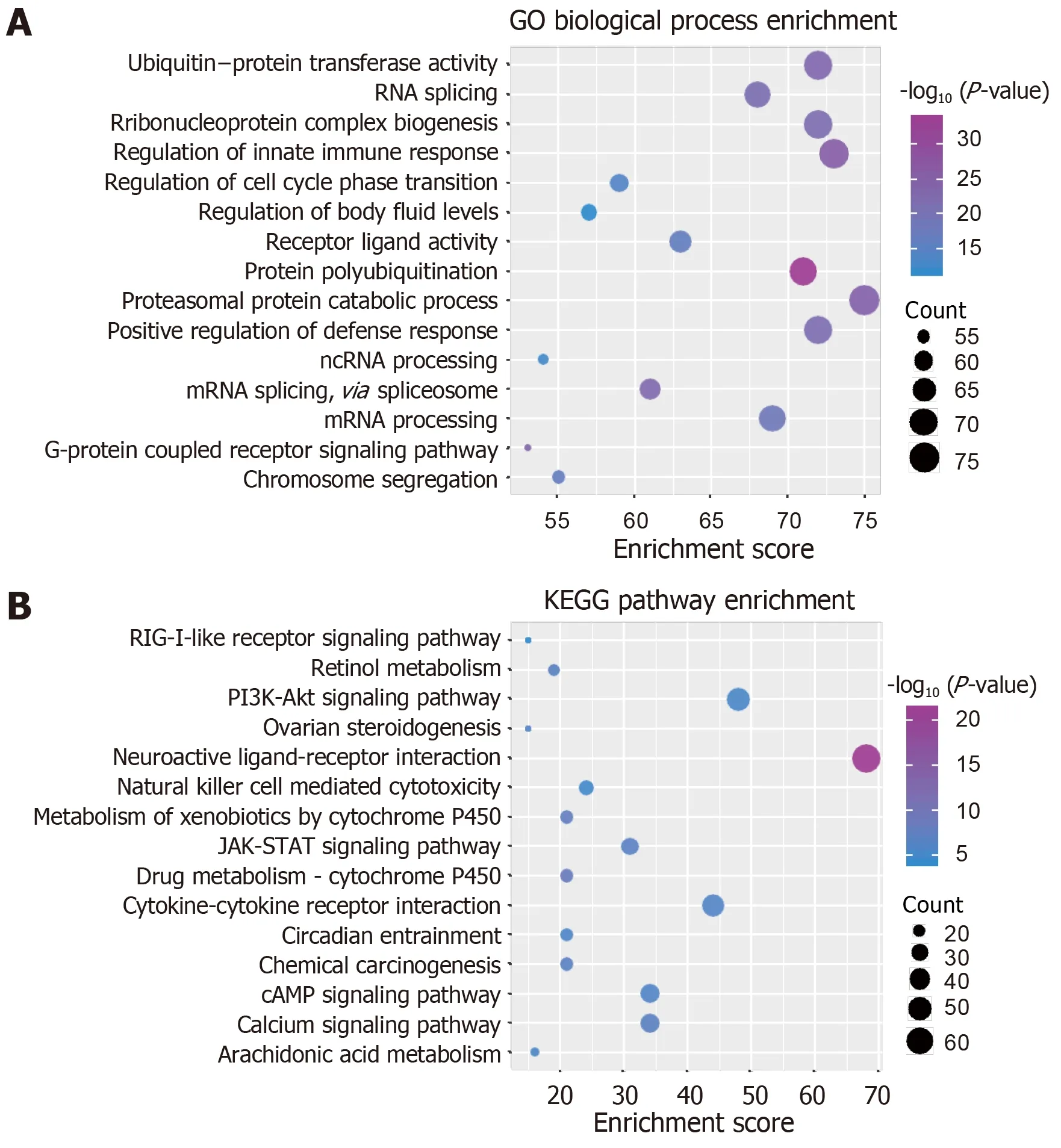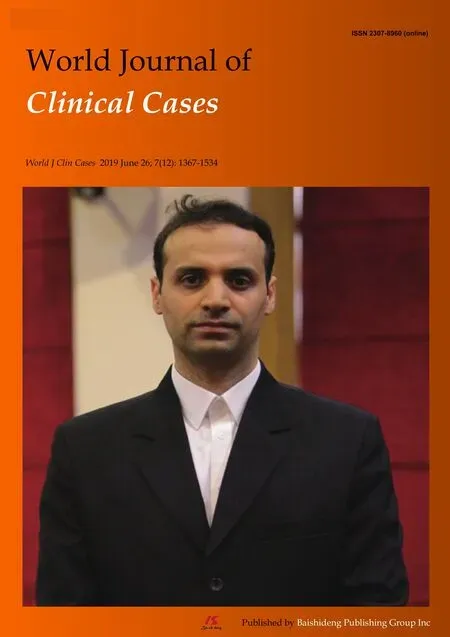Study on gene expression patterns and functional pathways of peripheral blood monocytes reveals potential molecular mechanism of surgical treatment for periodontitis
2019-08-14JinJiMaHongMeiLiuXiangHuaXuLiXinGuoQingLin
Jin-Ji Ma,Hong-Mei Liu,Xiang-Hua Xu,Li-Xin Guo,Qing Lin
Abstract
Key words: Peripheral blood mononuclear cells; Gene expression; Dysregulation module;Potential molecular mechanism; Gene expression pattern
INTRODUCTION
Periodontitis is a highly prevalent inflammatory disease in dental support tissues.It is caused by the growth of bacteria in the biofilm on the surface of teeth.As a mature periodontitis disease,it is characterized by progressive destruction of the supporting tissues of teeth.Periodontitis is a multifactorial disease.The susceptibility and severity of periodontitis are influenced by the polymorphism of immune response related genes,and are also determined by environmental and genetic factors[1,2].Relevant studies have shown that periodontal diseases are associated with various systemic diseases,including cardiovascular diseases such as stroke and atherosclerosis[3,4].Many data show that periodontitis affects 20% of the world's population.The prevalence of periodontitis in adults is 35%,and it increases with age,reaches a peak in the 45-50 age group[5-7].Periodontitis has a variety of risk factors,which may cause plaque,dental calculi,diabetes,and other diseases,and has multiple negative impacts on the quality of life of patients[5,8].Therefore,many scholars actively explore the pathogenesis of periodontitis.It is well known that bacterial infection is the main cause of periodontal disease,and the bacterial colonization of actinomycetes andPorphyromonas gingivalisis the main cause of periodontitis[9,10].On the one hand,the change of immune response in diabetic patients may cause periodontitis[11].On the other hand,the severity of periodontal disease may also be related to the expression of multiple metalloproteinase genes in the oral mucosal epithelium[12].Recent studies have shown that periodontitis,a chronic inflammatory oral infection,may have a profound impact on human health[13].As far as the potential relationship between periodontitis and systemic diseases is concerned,the changes of immune cell function induced by periodontitis may cause lipid metabolism disorder through the mechanism related to inflammatory cytokines,which has a serious negative impact on the health of whole body cells[13].
After understanding some of the pathogenesis of periodontitis,scholars around the world are actively studying the corresponding treatment mechanisms and inhibition methods.For example,according to van Winkelhoffet al[14],mechanical periodontal therapy combined with metronidazole and amoxicillin is effective for subgingival inhibition of actinomycete infection in patients with severe periodontitis.In addition,triclosan and copolymer toothpaste were found to be able to effectively control the development of plaque and gingivitis,thereby inhibiting the occurrence of periodontitis[15].Relevant studies have shown that periodontitis is essentially an inflammatory reaction in periodontal attachment caused by bacteria[16].Periodontal infection is not only related to chronic inflammation,but also to oxidative stress in severe periodontitis and its treatment[17].YKL-40,as a chitin-binding glycoprotein,may be an inflammatory marker of periodontitis,which has been confirmed by Kidoet al[18].On the one hand,as one of the biomarkers of periodontitis,pulp-like cell-1 may play an important role in the association between periodontal infection and systemic inflammatory response[19].On the other hand,the increased inflammatory response of higher serum C-reactive protein level may be as important as the promotion of periodontitis[20].
Previous data show that periodontal therapy can change the gene expression pattern of peripheral blood monocytes[21].Therefore,we can think that the gene expression of peripheral blood mononuclear cells also has a feedback regulation effect on periodontal therapy.Therefore,in our study,we proposed a comprehensive analysis method based on the gene expression patterns and functional pathways of peripheral blood mononuclear cells.It combined co-expression analysis and enrichment analysis of functional pathways,and focused on predicting a series of core non-coding RNAs (ncRNAs) and transcription factors to reveal the potential molecular mechanism of surgical treatment for periodontitis.
MATERIALS AND METHODS
Function modules related to co-expression analysis and recognition
First,the gene expression profiles of 3896 related genes in periodontitis were analyzed by weighted gene co-expression network analysis (WGCNA)[22]and the gene modules of co-expression were searched.Second,the weighted value of correlation coefficient was used to calculate the correlation coefficient between any two genes (Person Coefficient) by taking theNpower of the correlation coefficient.The connection between genes in the network obeys scale-free networks,which makes the algorithm more biologically meaningful.Then,a hierarchical clustering tree was constructed by the correlation coefficient between genes.Different branches of the clustering tree represent different gene modules,and different colors represent different modules.
Analysis of crosstalk and internal driving force among modules
First,Python was used to program the human protein interaction network (score >950) in String to generate 1000 random networks[23]while keeping the network size and the degree of each node unchanged.Second,according to the number of interaction pairs between significant modules obtained by random network statistics,the number of interaction pairs between modules was compared with the number of interaction pairs in random background.When the number of interaction pairs between modules was larger than that of interaction pairs in random background,it was called crosstalk.The method of calculating significant crosstalk was as follows:Under the background of random network,the number of interaction pairs between modules inNrandom networks was larger than that in real networks.The formula of calculatingP-value is:P=n/N(in this work,N= 1000).When aP-value was <0.05,there was a crosstalk interaction among modules.Then,Cytoscape[24]was used to display the significant crosstalk to visually observe the complex regulatory relationship between modules.In addition,Cytoscape was used for display and network analysis (including connectivity calculation).Finally,the genes with the greatest connectivity was screened and considered as the core molecule to regulate the progress of the module and identified as the intrinsic gene.These endogenous genes may represent potential key molecules in the effect of surgical treatment on periodontitis.
Functional and pathway enrichment analysis
Exploring the function and signal pathway of genes is often an effective means to study the molecular mechanism of disease,while the function and pathway of module gene participation can characterize the dysfunction mechanism of modules in the process of disease occurrence.Therefore,we used R language Cluster profiler package[25]to analyze the enrichment of GO function (pvalue Cutoff = 0.01,qvalueCutoff = 0.01) and KEGG pathway (pvalueCutoff = 0.05,qvalueCutoff = 0.2),respectively.According to the function and pathway of module gene participation,it was identified as a functional disorder module related to periodontitis.
Identification of transcription factors and ncRNAs that have regulatory effects on modules
First,we downloaded all human transcription factor target data in TRRUST V2 database[26],and obtained 116 interaction pairs of 94 transcription factors.Then,human ncRNA-protein data (score > 0.5) were downloaded from RAID 2.0 database[27],and 1678 interaction pairs involving 1198 ncRNAs were obtained.Then,pivot analysis based on these interaction data was performed to identify the regulatory effects of these transcription factors and ncRNAs on the modules.Pivot analysis refers to searching for at least two interacting drivers with the module in the target pair and calculating the significance of the interaction between the driver and the module according to the hypergeometric test.Transcription factors and ncRNAs with aP-value < 0.01 were the pivots of the significant regulatory module.Finally,the pivots were identified as the core pivots by statistical analysis.
RESULTS
Synergistic expression of periodontitis-related genes in the pathogenesis of periodontitis
Because the regulatory mechanism of periodontitis-related genes and the synergistic relationship between genes are not clear,we conducted in-depth research.First,a total of 337 genes related to surgical treatment of periodontitis was integrated into several databases.Second,we amplified 337 related genes and got 3896 related genes.We analyzed the WGCNA co-expression of the amplified genes and observed the expression of these genes in 15 patients with periodontitis.We found that eight groups of genes expressed synergistically in the group based on cohesion.Finally,these eight groups of genes were identified as eight functional modules,involving 2672 clusters of module genes (Figure 1).These functional modules may participate in different functions and pathways,representing different regulatory mechanisms to mediate the occurrence and development of periodontitis.
Interaction between dysfunctional modules
The intergenic regulation has always been complex and changeable.Similarly,the relationships between modules are complex and diverse.The interaction between modules is the pivot to maintain the relationship between modules and the whole world,and is also the key to exploring the function of modules.Exploring the crosstalk relationship between modules is helpful to deepen our understanding of the potential dysfunction mechanism of module regulation of periodontitis.Therefore,we conducted crosstalk analysis among modules based on the relationship between module genes.The results showed that there was a complex interaction between modules 2,3,4,5,6,7,and 8,while other modules had simple crosstalk (Figure 2).This crosstalk may represent the driving force between modules,which together regulate the potential molecular mechanism of peripheral blood monocytes in the surgical treatment of periodontitis.
Functional and pathway enrichment analysis and identification of dysfunctional modules
Studying the function and pathway of gene involvement is an important means to identify its mediated pathogenesis.In order to study the possible dysfunction caused by module gene disorder,we analyzed the enrichment of function and pathway of each module.The results showed that most of the functional modules were enriched in periodontitis-related functions and pathways.GO function and KEGG pathway enrichment analyses were carried out on the eight functional modules.A total of 45887 functions and 1796 KEGG pathway enrichment results were obtained.Among them,there are 5950 molecular functions,3976 cell components,and 35691 biological processes in which these genes participate (Figure 3,Table 1).It is worth noting that G-protein coupled receptor signaling pathway,coupled to cyclic nucleotide second messenger,and adenylate cyclase-modulating G-protein coupled receptor signaling pathway,which are significantly involved,may be identified as the core signaling pathways involved in the potential disorder mechanism of periodontitis.From the above data,we can find that these signaling pathways may be closely related to the molecular mechanism of periodontitis in the surgical treatment of peripheral blood monocytes.

Figure1 Clustering module for synergistic expression of genes related to periodontitis.
Identification of key regulatory factors driving the development of periodontitis
Further,our study of 2672 modular genes revealed that there were also target interactions among these genes.In-depth study of gene interaction within the module was then performed to calculate its connectivity and screen each module with the highest connectivity of the intrinsic genes.Eight endogenous genes includingEGF,RPS27A,andGNB3were screened from eight dysfunction modules.In addition,besides the module-driven genes,there were also key regulatory factors such as ncRNAs and transcription factors,which also play an indispensable role in the potential molecular mechanism of periodontitis.Scientific prediction of ncRNAs regulating dysfunction module genes is helpful for us to explore the posttranscriptional regulation mechanism of periodontitis.To this end,pivot analysis based on the targeting relationship between ncRNAs and genes was carried out to predict ncRNA regulators causing module dysfunction.We identified 198 ncRNAs that had significant regulatory effects on modules,involving 1678 ncRNA-module interaction pairs.Statistical analysis of the results showed that MALAT1 had a significant regulatory relationship with six dysfunction modules and may play an important role in the potential molecular mechanism of periodontitis,so it was identified as the core ncRNA.ANCR also plays an important role in the molecular mechanism of periodontitis.In addition,other ncRNAs may also play a role in driving the potential molecular mechanism of periodontitis.Similarly,transcription factors are equally important in regulating gene transcription.Many studies have shown that disordered expression of transcription factors may lead to the occurrence of various diseases.The dysfunction of periodontitis is also closely related to the dysfunction of transcription factors,which is also reflected in the regulation of dysfunction module by transcription factors.Therefore,we used pivot analysis to predict the module according to the regulation of genes by transcription factors.The results showed that there were 94 transcription factors involving 116 pivot-module interaction pairs.Statistical analysis of these transcription factors showed that NFKB1,SP1,and STAT3 had significant regulatory effects on 6 and 4 dysfunction modules,respectively,and they are likely to participate in the potential molecular mechanism of surgical treatment for periodontitis.These data suggest that transcription factors may play an important role in the molecular mechanism of surgical treatment of periodontitis.These transcription factors,which have significant regulatory effects on multiple dysfunction modules,have been identified as the core transcription factors driving the development of periodontitis.
DISCUSSION

Figure2 Crosstalk relationship between periodontitis modules.
It is well known that periodontitis is a multifactorial disease.Studies have shown that some clinical variability of periodontitis may be caused by genetic factors[28].As a high-risk inflammatory disease,periodontitis is considered a potential risk factor for systemic diseases such as cardiovascular diseases[20].Therefore,scholars around the world are actively exploring the detailed and specific pathogenesis and treatment mechanism of periodontitis.In this study,we investigated the gene expression patterns and functional pathways of peripheral blood mononuclear cells to reveal the potential molecular mechanism of the effect of surgical treatment on periodontitis.We proposed a comprehensive approach,which first integrated 3896 genes related to periodontitis and carried out co-expression analysis.Finally,eight functional modules with synergistic expression were identified,involving 2672 module gene clusters.Based on the results of functional enrichment,we also obtained that these modules are significantly involved in G-protein coupled receptor signaling pathway,coupled to cyclic nucleotide second messenger,and adenylate cyclase-modulating G-protein coupled receptor signaling pathway.Among them,adenylate cyclase has been found to be significantly involved in many signaling pathways,which also indicates that adenylate cyclase plays an important role in the signaling pathway in periodontitis.According to the research of Petrovichet al[29],the decrease of adenylate cyclase activity increases with the severity of periodontal pathological process,so it may play an important role in the pathogenesis of periodontitis.In addition,we also found that fibroblasts are also an important functional pathway involved in periodontitis,which is involved in the derivation of osteoclasts,contributing to the loss of attachment and destruction of periodontal ligaments and leading to periodontitis[30].
On the other hand,we identified the transcription factors involved in these dysfunctional modules for periodontitis-related genes,and obtained 94 transcription factors involving 116 pivot-module interaction pairs.Statistical analysis of these transcription factors revealed that NFKB1 had significant regulatory effects on five functional modules,which may be the core transcription factor involved in the potential molecular mechanism of surgical treatment for periodontitis.NFKB1 has been found to be involved in immune responses,cell proliferation,and other processes.NFKB1 is an important molecule involved in osteoclast differentiation,so inhibition of its growth can be used to treat periodontitis and various bone and joint diseases[31].Both SP1 and STAT3 have regulatory effects on the four functional modules.Transcription factor SP1 has been found in a large number of cases of periodontitis,indicating that it plays an important role in causing periodontitis[1].The expression of STAT3 was inhibited in gingival epithelial cells of patients with diabetic periodontitis.Therefore,down-regulation of STAT3 signaling could improve diabetic periodontitis to some extent,which was confirmed by Wanget al[32].These transcription factors can be considered as core transcription factors regulating the potential molecular mechanism of surgical treatment for periodontitis.
In addition,ncRNAs have been considered as important regulators of disease occurrence and development.We conducted pivot analysis based on the targeting relationship between ncRNAs and genes.The prediction results showed that there were 1198 ncRNAs that had significant regulatory effects on modules,including 1678 ncRNA-module interaction pairs.Statistical analysis of the results showed that MALAT1 had a significant regulatory relationship with six dysfunction modules,which were considered as key regulators of periodontitis.According to Ziebolz et al[33],MALAT1 can participate in the pathogenesis of periodontitis through a variety of pathways,including cytokine-cytokine receptor,adhesion molecule,and chemokine signal transduction pathway[2].In addition,ANCR has been found to play an important role in regulating the osteogenic differentiation of periodontitis.In that study,ANCR has been found to regulate two functional modules[33].At the same time,we screened a series of genes with the greatest connectivity,which were considered as the core driving molecules and identified as intrinsic genes.In total,there were eight endogenous genes,which may represent the potential key disorders in periodontitis treated by surgery.Analysis of these eight endogenous genes showed that EGF is aninhibitory factor for cell apoptosis[34].According to the research results of many scholars,it can be shown that EGF has the effect of bone catabolism,which may stimulate osteoclast formation and tooth movement,and has a certain regulatory effect on the occurrence and development of periodontitis[35].

Table1 Biological functions and signal pathway of gene participation (excerpts)
Based on the results of this study,we obtained several key functional modules of surgical treatment for periodontitis.These modules provide many proven periodontitis-related genes and candidate factors to be tested,which provide a theoretical basis for further study of periodontitis.We have also predicted a series of potential regulatory factors; these core regulatory factors may become the focus of future research on periodontitis.

Figure3 Functional and pathway identification of gene participation in surgical treatment for periodontitis.
ARTICLE HIGHLIGHTS
Research background
Periodontal diseases are associated with various systemic diseases,including cardiovascular diseases such as stroke and atherosclerosis,which seriously affect the quality of life for patients.
Research motivation
At present,little is known about the potential mechanism of surgical treatment for periodontitis.
Research objectives
To explore the mechanism of surgical treatment for periodontitis based on the gene expression of peripheral blood mononuclear cells.
Research methods
Co-expression analysis,enrichment analysis,crosstalk analysis,and pivot regulatory factor prediction
Research results
A total of 337 genes related to periodontitis were clustered into 8 co-expression modules.These genes are mainly involved in G-protein coupled receptor signaling pathway,coupled to cyclic nucleotide second messenger,and adenylate cyclase-modulating G-protein coupled receptor signaling pathway.In addition,94 transcription factors (including NFKB1,SP1,and STAT3) and 1198 ncRNAs (including MALAT1,CRNDE,and ANCR) regulatory module genes were identified.
Research conclusions
The key factors we have identified affect the recovery of periodontitis after surgery through a variety of biological processes and signaling pathways
Research perspectives
The results of this study provide a new theoretical basis and individualized treatment direction for follow-up treatment.
杂志排行
World Journal of Clinical Cases的其它文章
- Thoracotomy of an asymptomatic,functional,posterior mediastinal paraganglioma:A case report
- Novel heterozygous missense mutation of SLC12A3 gene in Gitelman syndrome:A case report
- Female genital tract metastasis of lung adenocarcinoma with EGFR mutations:Report of two cases
- Premonitory urges located in the tongue for tic disorder:Two case reports and review of literature
- Removal of pediatric stage IV neuroblastoma by robot-assisted laparoscopy:A case report and literature review
- Secondary lymphoma develops in the setting of heart failure when treating breast cancer:A case report
